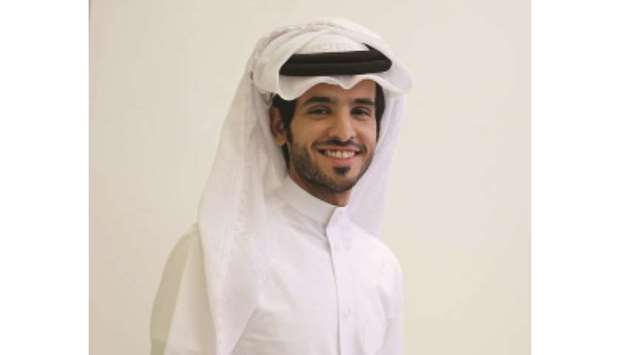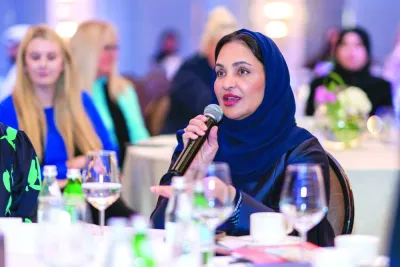When the regional neighbours of Qatar imposed an illegal blockade on the country, it took many by surprise. People, especially locals who had family members residing in different GCC countries, grappled with the idea of connecting with their loved ones. There was an initial element of shock and surprise. During these times of distress, a portrait comprising a black and white silhouette of His Highness the Amir Sheikh Tamim bin Hamad al-Thani’s profile with the slogan ‘Tamim Al Majd’ (Tamim the Glory) quickly became popular. It was everywhere from skyscrapers to profile photos on social media.
People rushed to write messages of support to their leader His Highness the Amir on the posters of the portrait everywhere, and showed strength and solidarity with fellow citizens. It instilled a sense of pride in everyone.
The man behind the popular portrait was the contemporary Qatari artist Ahmed bin Majed al-Maadheed. Although Ahmed had been drawing for many years, his portrait of His Highness the Amir carried a different meaning. It expressed his feelings about the blockade while simultaneously showing his love and faith in the leadership of Qatar. Ahmed shot to stardom soon after, and he achieved local and international fame. Community recently spoke to Ahmed about the ways in which ‘Tamim Al Majd’ portrait changed his life.
Excerpts
How did the iconic ‘Tamim Al Majd’ portrait change your life?
For me as an artist, ‘Tamim Al Majd’ is an icon of solidarity and our refusal of the blockade. It united all the people. When the siege happened, it became a symbol of blockade. And it changed my status in the country, and added a sense of responsibility for the community. I am drawing for the last 30 years and I draw in different styles, be it caricatures, animation, or portraits. I started drawing professionally in 2009. Compared to my other words, this icon is something completely different because it tells a real story. I drew it with my heart and my feelings gave my artwork meaning.
‘Tamim Al Majd’ has become a timeless piece of art that stands as a symbol of national unity and pride for all in Qatar — did the overwhelming response catch you by surprise?
The portrait tells the story of the blockade. When the siege was imposed on Qatar, my artwork started appearing everywhere, both in Qatar and internationally. So people started asking what is happening, and through the portrait we were able to tell them the story of the blockade. I saw people use it all over the world.
I made the portrait to express my feelings about the blockade. But I was not surprised by the reaction. The reality is that people love His Highness Sheikh Tamim bin Hamad al-Thani, and the overwhelming response to ‘Tamim Al Majd’ portrait was a result of that.
His Highness the Amir visited my exhibition and I was very honoured by his visit. Her Highness Sheikha Jawaher bint Hamad bin Suhaim al-Thani, wife of His Highness the Amir, Sheikh Khalifa bin Hamad bin Khalifa al-Thani and other members of the Qatari Royal family visited the exhibition and saw my artwork. I was really encouraged by their visit and support.
How would you describe the role of an artist in nation building?
I think as an artist it is really important that I have the role to convey a message. As a Qatari artist, I feel that people expect a lot of things from me. After the success of ‘Tamim Al Majd’, I became a popular Qatari artist not just locally but also internationally. I sense that people expect something good from me, so I am also careful about my art. I want to do artwork that has a reason and meaning and one that touches all the people. You should be able to feel your emotions through an artwork. In my case, it was different because suddenly, I was very popular. My case is not like any other artist where you can draw anything because people are paying close attention to my work. They see it on social media platforms. I think in that sense, responsibility is very important. When you succeed, you become an icon for your family, youth. And so I want to see myself through better art.
What are your thoughts on the blockade of Qatar and how has it impacted your life?
I’m a sensitive guy. I can feel your pain even when you’re quiet. When the blockade happened I was shocked. Qatar is my family — it’s everything to me. And what happened… you don’t expect it from your neighbour. It was like someone stabbed me in the back. I felt the pain of the people around me. But I think it made us stronger as a nation. We realised that we can survive even without the support of the neighbours. We are thankful to His Highness the Amir Sheikh Tamim bin Hamad al-Thani everything that he has done for Qataris and the expatriates. Despite the blockade, we continue to succeed and prosper because we believe in our nation.
Before the invention of photography, a painted, sculpted, or drawn portrait was the only way to record the appearance of someone. With the advent of technology came the digital and new media art, how has that affected art in your opinion?
We are living in an age where technology is everywhere. Anyone who is interested in my artwork can instantly see it through social media. I believe technology is very important, especially with regards to art and innovation. It helps you reach a larger audience and you are able to touch the lives of many more people.
Continued to Page 4
You’ve spoken about the plagiarism of some of your artwork in the past. How did that conversation begin?
There are two things I would like to discuss here. When people like your art, they like to copy and draw it themselves. But when you start using my work commercially without my knowledge, I don’t approve of it. As it is, I don’t accept all commercial ventures. The other thing is that if it’s an image or artwork related to the HH the Amir such as ‘Tamim Al Majd’, then you have to be respectful about it. You cannot use it just anywhere. It is to be held in high regard as a public symbol and slogan that should not be disrespected or undermined. The original ‘Tamim Al Majd’ portrait is now in National Museum of Qatar.
Can you talk about some of the projects that you are currently working on?
I am looking forward to do many good things for Qatar. I have been doing a lot of exhibitions in Qatar as well as outside. I don’t see myself just as an artist. My art is my tool to send my message. Actually with the coronavirus pandemic, there is now an increased focus on using art on digital platforms. I started competitions to encourage people to make art about coronavirus. I’ve also created artwork urging people to stay at home as a campaign to stay home and be healthy. I’ve many ideas about the pandemic and how it has affected us and plan on working on artwork related to it.

..


